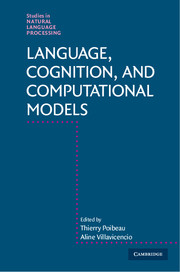Book contents
- Frontmatter
- Contents
- Figures
- Tables
- Contributors
- Part I About This Book
- Part II Models of Neural and Cognitive Processing
- Part III Data Driven Models
- 5 Putting Linguistics Back into Computational Linguistics
- 6 A Distributional Model of Verb-Specific Semantic Roles Inferences
- 7 Native Language Identification on EFCAMDAT
- 8 Evaluating Language Acquisition Models: A Utility-Based Look at Bayesian Segmentation
- Part IV Social and Language Evolution
- Index
- References
8 - Evaluating Language Acquisition Models: A Utility-Based Look at Bayesian Segmentation
from Part III - Data Driven Models
Published online by Cambridge University Press: 30 November 2017
- Frontmatter
- Contents
- Figures
- Tables
- Contributors
- Part I About This Book
- Part II Models of Neural and Cognitive Processing
- Part III Data Driven Models
- 5 Putting Linguistics Back into Computational Linguistics
- 6 A Distributional Model of Verb-Specific Semantic Roles Inferences
- 7 Native Language Identification on EFCAMDAT
- 8 Evaluating Language Acquisition Models: A Utility-Based Look at Bayesian Segmentation
- Part IV Social and Language Evolution
- Index
- References
Summary
Abstract
Computational models of language acquisition often face evaluation issues associated with unsupervised machine learning approaches. These acquisition models are typically meant to capture how children solve language acquisition tasks without relying on explicit feedback, making them similar to other unsupervised learning models. Evaluation issues include uncertainty about the exact form of the target linguistic knowledge, which is exacerbated by a lack of empirical evidence about children's knowledge at different stages of development. Put simply, a model's output may be good enough even if it does not match adult knowledge because children's output at various stages of development also may not match adult knowledge. However, it is not easy to determine what counts as “good enough” model output. We consider this problem using the case study of speech segmentation modeling, where the acquisition task is to segment a fluent stream of speech into useful units like words. We focus on a particular Bayesian segmentation strategy previously shown to perform well on English, and discuss several options for assessing whether a segmentation model's output is good enough, including cross-linguistic utility, the presence of reasonable errors, and downstream evaluation. Our findings highlight the utility of considering multiple metrics for segmentation success, which is likely also true for language acquisition modeling more generally.
Introduction
A core issue in machine learning is how to evaluate unsupervised learning approaches (von Luxburg, Williamson, & Guyon, 2011), since there is no a priori correct answer the way that there is for supervised learning approaches. Computational models of language acquisition commonly face this problem because they attempt to capture how children solve language acquisition tasks without explicit feedback, and so typically use unsupervised learning approaches. Moreover, evaluation is made more difficult by uncertainty about the exact nature of the target linguistic knowledge and a lack of empirical evidence about children's knowledge at specific stages in development. Given this, how do we know that a model's output is “good enough”? How should success be measured? To create informative cognitive models of acquisition that offer insight into how children acquire language, we should consider how to evaluate acquisition models appropriately (Pearl, 2014; Phillips, 2015; Phillips & Pearl, 2015b).
- Type
- Chapter
- Information
- Language, Cognition, and Computational Models , pp. 185 - 224Publisher: Cambridge University PressPrint publication year: 2018



